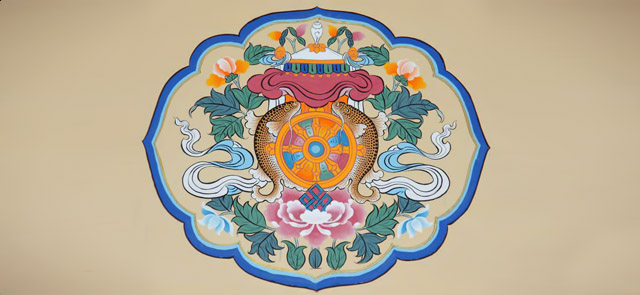The Setting in Motion of the Wheel of Dharma [Chin.: zhuǎnfǎlúnjīng转法轮经 | Sanskr.: धर्मचक्रप्रवर्तन सूत्र - Dharmacakra Pravartana Sūtra] is considered to be a record of the first teaching given by the Buddha after he attained enlightenment. This discourse was given to the five ascetics [Kondañña, Vappa, Bhaddiya, Mahanāma, and Assaji] who were his former companions, at the Deer Park [Chin.: xiānrényuàn仙人苑 | Sanskr.: Mṛgadāva] in Isipatana, now called Sarnath [Sanskr.: सारनाथ Sārnath], near Benares, India.
The Buddha started the discourse by advising the five ascetics to give up two extremes. These were indulgence in sensual pleasures and the tormenting of the body (self-indulgence and self-mortification).
He advised against too much sensual pleasure because these pleasures were base, worldly, not noble and unhelpful in spiritual development. On the other hand, tormenting the body was painful, not noble and also unhelpful in spiritual development. He advised them to follow the Middle Way [Chin.: zhōngdào 中道 | Sanskr.: Madhyamāpratipad], which is helpful in seeing things clearly, as they are, and in attaining knowledge, higher wisdom, peace, and enlightenment or nirvana.
The Buddha then taught the five ascetics the Four Noble Truths. They are: the truth of suffering; its cause; its end; and the way to its end. Everything in this world is full of suffering, and the cause of suffering is craving. The end of suffering is nirvana. The way to the end of suffering is via the Noble Eightfold Path [Chin.: Bāzhèngdào 八正道| Sanskr.: āryāṣṭāṅgamārga].
The Buddha said that he was enlightened only after he understood these Four Noble Truths [Chin.: sìshèngdì 四圣谛 | Sanskr.: चत्वारि आर्यसत्यानि catvāri āryasatyāni].
The Noble Eightfold Path has eight parts or factors:
1. Right understanding means to know and understand the Four Noble Truths.
2. Right attitude means to have three kinds of thoughts or attitudes:
(a) Thoughts of renunciation or an attitude of “letting go”.
(b) Thoughts of goodwill to others, which are opposed to ill will.
(c)Thoughts of harmlessness, as opposed to cruelty.
3. Right speech deals with refraining from falsehood, such as telling lies or not telling the truth; tale-bearing or saying bad things about other people; harsh words and frivolous talk such as gossiping.
4. Right action deals with refraining from killing, stealing and sexual misconduct.
5. Right livelihood deals with the five kinds of trade which should be avoided in order to lead a noble life. They are: trading in arms (weapons), living beings (breeding animals for slaughter), intoxicating drinks and poison.
6. Right effort has four parts using meditation:
(i) To try to stop unwholesome thoughts that have arisen
(ii) To prevent unwholesome thoughts from arising.
(iii) To try to develop good thoughts
(iv) To try to maintain good thoughts that have arisen
7. Right mindfulness is also fourfold. It is mindfulness of the body, mindfulness of feelings/sensations, mindfulness of thoughts passing through the mind and mindfulness of Dharma.
8. Right concentration is one-pointedness of mind as developed in meditation.
These eight factors can be grouped into three smaller groups, as follows:
Morality [Chin.: shīluó 尸羅| Sanskr.: Śīla शील]: right speech, right action, right livelihood.
Concentrated mind [Chin.: sānmódì三摩地 | Sanskr.: Samādhi समाधि]: right effort, right mindfulness, right concentration.
Wisdom [Chin.: bōrě般若| Sanskr.: prajñā ]: right attitude, right understanding.
These three -morality, concentration and wisdom- are the three stages on the path to mental purity whose object is Salvation.







